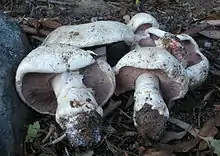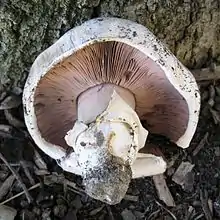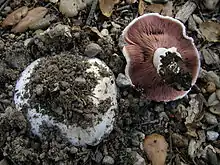| Agaricus bernardii | |
|---|---|
 | |
| Scientific classification | |
| Domain: | Eukaryota |
| Kingdom: | Fungi |
| Division: | Basidiomycota |
| Class: | Agaricomycetes |
| Order: | Agaricales |
| Family: | Agaricaceae |
| Genus: | Agaricus |
| Species: | A. bernardii |
| Binomial name | |
| Agaricus bernardii | |
| Synonyms[1] | |
| Agaricus bernardii | |
|---|---|
| Gills on hymenium | |
| Cap is flat or convex | |
| Hymenium is free | |
| Stipe has a ring | |
| Spore print is brown | |
| Ecology is saprotrophic | |
| Edibility is choice | |
Agaricus bernardii, commonly called the salt-loving agaricus,[2] or salt-loving mushroom, is an agaric fungus in the family Agaricaceae. The mushroom's thick stem is usually shorter than the diameter of the cap, which ranges from 5–15 centimetres (2–6 inches) and is convex to flattened. The cap surface is whitish to buff, and can develop scales or warts in age. The gills are initially pink before turning brown when the spores mature. The flesh turns reddish when it is cut or bruised. It resembles species such as A. bitorquis.
Found in Eurasia, North America, New Zealand, and Australia, A. bernardii is a salt-tolerant species that grows in salt marshes, dunes, and coastal grassland. An edible mushroom, it is stronger in flavor but similar to the store-bought button mushrooms, A. bisporus.
Taxonomy
Taxonomic history
The species was first described by French mycologist Lucien Quélet as Psalliota bernardi in 1879, based on collections made in La Rochelle, a seaport on the Bay of Biscay (France).[3] Pier Andrea Saccardo transferred it to Agaricus in 1887.[1]
Modern classification
The infrageneric (below genus-level) classification of A. bernardii is not known with certainty. In his 1978 proposed classification, Paul Heinemann placed it in the subsection Bitorques of the section Agaricus.[4] Although the species has some similarities with species in the section Duploannulatae based on the structure of its veil and its tendencies towards rufescence (developing a red coloration), molecular analysis shows that it does not belong in this section.[5][6] An earlier (1999) analysis suggested that it is closely related to the "Agaricus clade", which contains A. subperonatus, A. devoniensis, A. bisporus, A. spissicaulis, A. bitorquis, and A. impudicus.[7] In 1986, Henri Romagnesi placed it in section Chitonioides;[8] Solomon Wasser demoted this to a subsection of Duploannulatae in 1995,[9] and later provided molecular support for his decision. In addition to A. bernardii, species in Wasser's concept of subsection Chitonioides include A. rollanii, A. bernardiiformis, A. gennadii, A. pequinii, and A. nevoi.[10]
Etymology
The species was named after the original collector, G. Bernard.[3] A. bernardii is commonly known as the salt-loving mushroom.[11]
Synonyms include Psalliota bernardii, Pratella bernardii, Fungus bernardii, and Agaricus campestris subsp. bernardii.[1]
Description

Fruit bodies of A. bernardii have caps that range in shape from convex to flattened, and reach a diameter of 5–15 centimetres (2–6 inches). The cap surface is dry and smooth, with a white or buff color that can develop brownish spots in maturity. In age, the surface often forms scales or warts. The flesh is thick, firm, and stains reddish-orange or reddish-brown when cut, although this reaction can be slow to develop.[12] Its odor ranges from mild to briny to pungent.[13] The gills are free from attachment to the stem, and packed close together. Initially grayish-pink to pinkish, they turn reddish-brown and then chocolate brown as the spores mature. The stem is solid (i.e., not hollow), firm, and measures 4–10 cm (1+1⁄2–4 in) long by 2–4 cm (1–1+1⁄2 in) thick. A thick, white, rubbery partial veil covers the gills of the immature mushroom, and eventually remains as a ring on the middle of the stem.[12]
A. bernardii mushrooms produce a dark brown spore print. The spores are smooth, broadly elliptical, and have dimensions of 6–7.5 by 5–6 μm.[13] The basidia (spore-bearing cells) are four-spored and club-shaped, measuring 14–25 by 4–7 μm; the sterigmata are 4–5 μm. Cheilocystidia (cystidia on the gill edge) are broadly club-shaped to cylindrical, hyaline (translucent), and measure 17–30 by 4–8 μm.[12]
Similar species

A. bitorquis, also edible, has a similar appearance, but can be distinguished by its double ring, and the lack of a fishy or briny odor. Additionally, A. bitorquis does not stain reddish when cut, and usually does not have a scaly or warty cap.[13] The Hungarian species A. bernardiiformis, named for its similarity to A. bernardii, is distinguished from the latter by its smaller spores (6.2–8.2 by 5.4–6.2 μm) and its club-shaped cheilocystidia that measure 17–35 by 7–9.5 μm.[10] MycoBank, however, considers the two species to be conspecific.[14]
Distribution and habitat
The species is found in Asia, Europe, North America[11] (including Mexico)[15] and New Zealand.[12]
A. bernardii is a saprobic species.[16] Its mushrooms fruit singly, scattered, or in groups on the ground. They grow in sandy soils, lawns, and in habitats with a high salt concentration, like along ocean coasts and salt marshes.[13] Once primarily a maritime species, the fungus has spread inland to roadside verges where salt has been applied to de-ice the roads.[11][17] Fruit bodies sometimes form underground.[13] Mushrooms can also grow in fairy rings, especially when in grasslands or pastures.[12]
Ecology
A Czech study determined that the mushrooms will strongly bioaccumulate silver from contaminated soil. Although the average concentration of silver in the soil is typically less than 1 milligram per kilogram of soil, it can be significantly elevated near industrial sites such as mines and smelters. The concentration of silver in the caps—which reached levels of up to 544 mg per kg of mushroom tissue (dry weight)—was about twice that of the stems.[18]
Uses
Although the mushrooms sometimes have an odor that is briny or pungent,[11] they are edible and good.[19] David Arora compares it to the closely related A. bitorquis, "but a little chewier".[13]
See also
References
- 1 2 3 "Agaricus bernardii (Quél.) Sacc. 1887". MycoBank. International Mycological Association. Retrieved 2012-08-13.
- ↑ Arora, David (1986). Mushrooms demystified: a comprehensive guide to the fleshy fungi (Second ed.). Berkeley: Ten Speed Press. ISBN 978-0-89815-169-5.
- 1 2 Quélet L. (1878). "Quelques especes nouvelles de Champignons" [Some new species of mushrooms]. Bulletin de la Société botanique de France (in French). 25 (4): 287–92. doi:10.1080/00378941.1878.10827918.
- ↑ Heinemann P. (1978). "Essai d'une clé de détermination des genres Agaricus et Micropsalliota". Sydowia. 30: 6–37.
- ↑ Chellan MP, Kerrigan RW, Callac P (2003). "A phylogenetic reconstruction and emendation of Agaricus section Duploannulatae". Mycologia. 95 (1): 61–73. doi:10.2307/3761962. JSTOR 3761962. PMID 21156589.
- ↑ Kerrigan RW, Callac P, Parra LA (2008). "New and rare taxa in Agaricus section Bivelares (Duploannulati)". Mycologia. 100 (6): 876–92. doi:10.3852/08-019. JSTOR 20445021. PMID 19202842. S2CID 25519596.
- ↑ Mitchell AS, Bresinsky A (1999). "Phylogenetic relationships of Agaricus species based on ITS-2 and 28S ribosomal DNA sequences". Mycologia. 91 (5): 811–9. doi:10.2307/3761534. JSTOR 3761534. Archived from the original on 2015-09-23. Retrieved 2012-10-06.
- ↑ Romagnesi H. (1986). "Sur le genre Chitonia (Fr.) Karst" [About the genus Chitonia (Fr.) Karst.]. Bulletin de la Société Mycologique de France (in French). 102: 115–20.
- ↑ Wasser SP. (1995). "New and noteworthy species of the genus Agaricus L.: Fr. emend. Karst. from Israel". Documents Mycologiques. 25: 469–78.
- 1 2 Didukh M, Vilgalys R, Wasser SP, Isihuemhen OS, Nevo E (2005). "Notes on Agaricus section Duploannulati using molecular and morphological data". Mycological Research. 109 (6): 729–40. doi:10.1017/S0953756205002443. PMID 16080396.
- 1 2 3 4 Roberts P, Evans S (2011). The Book of Fungi. Chicago, Illinois: University of Chicago Press. p. 33. ISBN 978-0226721170.
- 1 2 3 4 5 Mitchell AD, Walter M (1999). "Species of Agaricus occurring in New Zealand". New Zealand Journal of Botany. 37 (4): 715–25. doi:10.1080/0028825X.1999.9512665.
- 1 2 3 4 5 6 Arora D. (1986). Mushrooms Demystified: A Comprehensive Guide to the Fleshy Fungi. Berkeley, California: Ten Speed Press. p. 322. ISBN 0-89815-169-4.
- ↑ "Agaricus bernardiiformis Bohus 1975". MycoBank. International Mycological Association. Retrieved 2012-10-06.
- ↑ Pérez-Silva E, Aguirre-Acosta E (1986). "Macromicetos de zonas urbanas de México. I. Área Metropolitana" [Macromycetes of urban zones from Mexico I. Metropolitan area]. Revista Mexicana de Micología (in Spanish). 2: 187–96. ISSN 0187-3180.
- ↑ Kuo M. (October 2007). "Agaricus bernardii". Retrieved 2012-10-06.
- ↑ Scott NE. (1985). "The updated distribution of maritime species on British roadsides". Watsonia. 15 (4): 381–6. ISSN 0043-1532.
- ↑ Borovička J, Kotrba P, Gryndler M, Mihaljevič M, Řanda Z, Rohovec J, Cajthaml T, Stijve T, Dunn CE (2010). "Bioaccumulation of silver in ectomycorrhizal and saprobic macrofungi from pristine and polluted areas". The Science of the Total Environment. 408 (13): 2733–44. Bibcode:2010ScTEn.408.2733B. doi:10.1016/j.scitotenv.2010.02.031. PMID 20303145.
- ↑ Davis RM, Sommer R, Menge JA (2012). Field Guide to Mushrooms of Western North America. University of California Press. p. 223. ISBN 978-0-520-95360-4.
External links
- Mushroom Observer Images
- Rogers Mushrooms Images and description